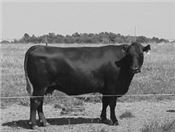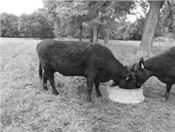Cattle Question: To Shed Or Not To Shed?
MT. VERNON, MO.
It is springtime in the Ozarks and that means cattle owners will be working their spring and fall-calving cows and calves.
“In addition to a long list of health management practices you’ll be doing as the cattle leave the chute, I'd suggest someone in your crew hair score the cows. May is an ideal time to do it," said Eldon Cole, field specialist in livestock with University of Missouri Extension.
Hair scoring is not “rocket science,” but it may help producers develop a cow herd that is more productive, more attractive and better able to cope with heat stress due to fescue toxicosis.
“Researchers find cows that shed their winter coats by mid-May, wean calves averaging around 14 pounds more. Early hair shedding is a heritable trait (0.38-0.40). This heritability is comparable to weaning weight, so genetic progress can be made,” said Cole.
Anyone familiar with toxic fescue symptoms realize late shedders show heat stress as temperatures reach the upper 70’s, low 80’s. That temperature and elevated humidity set the cow up for poor production and reproduction.
Hair shedding scores range from 1 to 5. The 1 score is for early shedders that have completely shed off by May. The 1's stick out in most herds and if producer is scoring during April they may not find many.
A 2 cow will be 75 percent shed off. The remaining long hair will be on the lower part of the body including some on the lower hindquarters. The 3 cow is 50 percent shed. When scoring in April producers will find quite a few 4’s which indicates they are only 25 percent shed. Most of the shed area is only in the forequarters and the topline. A 5 score will still be carrying her winter coat.
“I’ve hair scored a lot of cattle since 1993 when we started doing it on steers involved in a grazing study with “hot” Kentucky 31 fescue at the University of Missouri Southwest Research Center, Mt. Vernon. It's a useful tool and can aid in selecting and culling replacement heifers, cows and bulls,” said Cole.
The University of Missouri is currently involved in a project with other institutions to identify beef cattle well-suited to their environment. One of the factors used in that project is hair shedding.
“The data collection started in 2016 and includes reporting on cattle from southwest Missouri. Many of the cattle have been DNA tested and that information may assist in the development of a hair shedding expected progeny difference (EPD),” said Cole. ∆

A 1 hair score on this Angus cow.

A 5 hair score on this Angus cow.
Photos credit: MU Extension